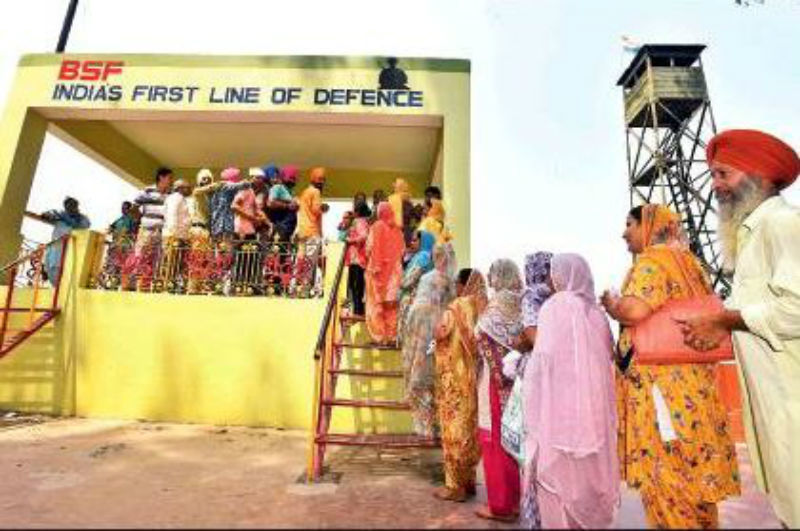Gurdwara Kartarpur Sahib
This is a collection of articles archived for the excellence of their content. |
2018: darshan through binoculars

From: Yudhvir Rana, Why Indian Sikhs need binoculars for darshan across the border, September 16, 2018: The Times of India
The queues have become longer at the darshan sthal, near the international border in Punjab’s Gurdaspur district. The last few days have seen Sikhs converge in greater numbers from all over India to catch a glimpse of one of the holiest Sikh shrines — Gurdwara Kartarpur Sahib, situated 4.5km away in Pakistan’s Narowal district, across the Ravi river.
The increase in footfalls comes after Punjab minister Navjot Singh Sidhu’s announcement last month that Pakistan’s army chief, Gen Qamar Javed Bajwa, had assured him of plans to open the route from Dera Baba Nanak to Gurdwara Kartarpur Sahib for Guru Nanak’s 550th birth anniversary next year. Last week Pakistan’s information minister Fawad Ahmad Chaudhry stated that the Imran Khan government was planning to allow “visa-free direct access” to Kartarpur Sahib for Indian Sikh pilgrims.
For now, a glimpse is all the pilgrims get from the viewing point. On a clear day, devotees can see the white painted structure and dome of Kartarpur Sahib from the darshan sthal, constructed by the BSF, a little short of the border fence. The scene is partially hindered by elephant grass growing on the Pakistani side. A pair of binoculars, tightly secured in an iron case, comes handy for a better view. The devotees fold their hands, recite prayers and bow in reverence.
Sikh history says that after completing his famous four journeys, Guru Nanak came and settled down in Kartarpur Sahib in 1522, where he lived a simple life tilling fields for the last 17 years of his life on earth. Later, a gurdwara was constructed there.
Baljinder Kaur, a pilgrim from Patiala, says that every Sikh in their daily ardas (prayer) seeks unhindered access to Nankana Sahib and other gurdwaras in Pakistan. “Hopefully, our prayers will be heard soon,” she says.
Jagtar Singh, vice-president of Gurdwara Guru Angad Dev Ji in Salzburg, Austria, says he has been coming for darshan to the dera for the past 11 years. “A pilgrim corridor will be a milestone in forging cordial relations between India and Pakistan,” he adds.
So far though, there has been no official confirmation from either Pakistan or India. But the recent visit of the Indian high commissioner, Ajay Bisaria, to Kartarpur Sahib is being considered a significant development. The earlier government had prevented Bisaria from visiting Gurdwara Panja Sahib near Rawalpindi on two occasions.
Over the years, a number of proposals and initiatives have been made to take the issue forward. In 1999, then Pakistan president Pervez Musharraf had offered to allow Indian Sikhs to visit Kartarpur Sahib from Dera Baba Nanak without passport and visa. Nothing came of it. A decade later, on October 1, 2010, the Punjab assembly passed a resolution asking the Union government to take up the corridor issue with the Pakistan government.
Rajya Sabha MP from Gurdaspur, Partap Singh Bajwa, had even floated the idea of swapping uninhabited land in Gurdaspur district with Kartarpur Sahib land in Pakistan. There is one instance of this after Partition — India swapped 12 villages near Sulemanki Headworks in Punjab’s Fazilka district with Pakistan for getting back Hussainiwala, the site of the famous National Martyrs Memorial where Bhagat Singh and some other martyrs of the freedom struggle were cremated.
In 2010, the US-based Institute of Multi Track Diplomacy had prepared a feasibility report of ‘Kartarpur Marg’, submitting it to the Indian and Pakistani ambassadors in Washington DC. The report pegged the cost of construction at Rs 106 crore for India and Rs 16 crore for Pakistan.
Meanwhile, the Shiromani Gurdwara Prabandhak Committee (SGPC) has offered to construct the corridor on its own if both governments agree. “We don’t want anyone to play politics on such a sensitive religious issue,” says SGPC president Gobind Singh Longowal.
Various international Sikh delegations have also been lobbying for a corridor with Pakistani officials. Download The Times of India News App for Latest India News.
